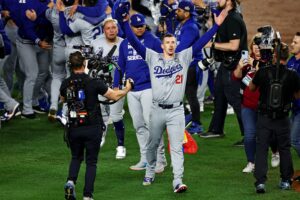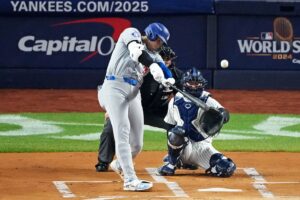Hunter Renfroe Coming up Big for San Diego Padres
(Note: All 2019 season statistics are up to and including games played on Saturday, May 25th.)
Hunter Renfroe is in his third full season with the San Diego Padres. During his budding career, the right fielder has hit 70 home runs while compiling a career batting average of .245. This season, he has had some big hits – namely the walk-off grand slam on May 5th against Los Angeles Dodgers closer Kenley Jansen. In Saturday’s blowout of the Toronto Blue Jays, he went 4-for-6 with two home runs, three RBI, and four runs scored. This season, 67% of his hits have been for extra bases. The National League average is 37%. It is truly remarkable.
A Closer Look at Hunter Renfroe
The 67% number, which leads all regulars in the National League, merits closer examination, however. Only two other National League regulars with a batting average at or above .240 are even in the 60s – Washington Nationals third baseman Anthony Rendon (62%, .324 average) and Arizona Diamondbacks pitcher Zack Greinke (63%, .320 average). Los Angeles Dodgers center fielder Joc Pederson (.248 average) and New York Mets first baseman Pete Alonso (.250 average) are both at 59%, but after that, no one else in the National League is even close to the 60% mark.
For Renfroe to be an elite hitter, he needs to get his strikeouts under control. In his first full season in the majors, he struck out in 29.2% of his plate appearances. Last season (his second full season), he reduced that to 24.7%. This season, it is 26.6%. If he gets that percentage at or below 20%, he has tremendous potential.
Historical Parallel for Hunter Renfroe
The beginning to Renfroe’s career has a striking parallel to another outfielder who hit the cover off the ball but struck out a lot. This player got his strikeout rate down into the teens (percentage-wise) for four consecutive years in his prime and put up Hall of Fame numbers before it went back up into the 20s. Who is this mystery player?
(Drum roll…)
It is Reggie Jackson. Before going crazy, look at their percentages. Jackson’s first full season was 1968. Renfroe’s was 2017. Here are their numbers:

Their at-bats per strikeout are identical. Renfroe hit home runs slightly more often but also struck out slightly more often. They each put the ball in play 58% of the times that they batted. The most glaring differences are their rates for walks and extra-base hits. Now look at their percentages for their third full seasons. (1970 for Jackson; 2019 for Renfroe)

Their strikeout rates are almost identical. The big differences are the home run rate, extra-base hit rate, and walk rate. Renfroe is hitting homers and extra-base hits far more often than Jackson did in 1970. However, Jackson walked three times as often. Using extrapolation, we can predict what Renfroe’s final statistics will be for this season if his rates stay the same. Here is how they line up with Reggie Jackson’s offensive totals from 1970.

Looking Ahead
Jackson was able to get his strikeout rate down for a few years. In 1971, it was 25.1%, and in 1972, it was 21.8%. He finally pulled it below 20% in 1973 – getting it to 17.7%. That year, he hit .293/.383/.581 with 32 homers and a career-high 117 RBI en route to winning the American League MVP. It was the first of four consecutive years where his strikeout rate was in the teens. After that, the rate was still in the 20s, but Jackson continued to produce. He ended his 21-year career with 2584 hits, 463 doubles, 563 home runs, and a still-standing-record 2567 strikeouts. If Renfroe can get his strikeouts under control, it is not far-fetched to think that he can put up similar totals to Jackson. What will matter more to Padres fans, however, is whether Renfroe’s stats will lead to the same success Jackson had in the postseason, where he won a grand total of five World Series rings. Jackson’s first year in the postseason was his fourth full season in the majors. If Renfroe’s year lines up with the above projection, his first postseason could come in his third.
(Note: Statistics were compiled by the author from www.baseball-reference.com.)
Main Photo
Embed from Getty Images






